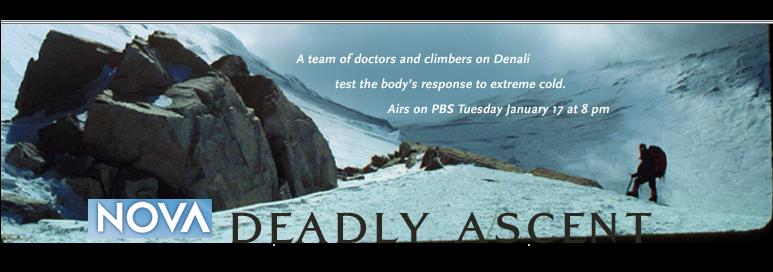
In an exploration of extreme medical science, NOVA ascends Alaska's Denali—aka Mt. McKinley—to try to solve the mystery of high-altitude deaths on one of the most dangerous mountains on Earth. NOVA chronicles daring mountain rescues and emergency medical evacuations as it accompanies an expedition team of researchers and experts employing the latest NASA technology to investigate the lethal diseases attacking climbers all over the world.
Each year, more than 1,000 people attempt to reach Denali's summit. Nearly half of those fail and several die trying—sliding off of icy cliffs, crushing bones against rocks, falling into hidden crevasses, or simply getting lost and succumbing to the cold. It's no secret—cold can kill (see Body Breakdowns). But why? Even some of the most physically fit and well-equipped climbers still die on Denali, debilitated by a strange and confounding sickness.
NOVA joins a team of medical researchers, rescuers, world-class mountaineers, military special forces, and an astronaut taking part in a study by Dr. Peter Hackett, who turns the mountain's vertical arctic landscape into a high-altitude lab. Home to the highest medical rescue camp in the U.S., Denali offers a unique opportunity, since it's one of the few places on Earth where doctors can study humans in extreme conditions.
The program shows viewers the firsthand experiences of the mountaineers, who must endure blistering cold, piercing winds, and dizzying altitudes while navigating treacherous icy terrain to reach the 20,320-foot summit. Along the expedition route, one team member will battle symptoms of the high-altitude cases that the researchers are trying to solve.
The NOVA film crew is there when another member of the team is lowered into an icy abyss in an experiment demonstrating how the inevitable drop in core temperature stymies escape attempts by a fallen climber. Without an expedition team to haul them to safety, it's easy to see why more than 85 percent of climbers who fall into crevasses never make it out.
Gripping footage captures the harrowing rescues, emergency treatment, and life-saving evacuations that mark the climbing season on Denali, where rescuers put their own lives at risk in order to save injured climbers. The film chronicles life-and-death decisions made at the medical camp and also features interviews with Special Forces pilots of the Air National Guard, who perform most of the air evacuations.
Unique to this expedition is new technology from NASA—a radio thermometer pill that, once swallowed, logs core body temperature, sending readings to a handheld receiver. The body's core is made up of three essential organs: the heart, lungs, and brain. If the temperature of the core—98.6°F—drops just three degrees below normal, these vital organs begin to shut down due to hypothermia, the first step toward freezing to death. Equally dangerous is hyperthermia, which sets in when the body heats up to 101°F or more from the exertion of climbing. NASA's radio pill allows researchers to monitor these life-threatening symptoms with precision for the first time (see Predicting Survival).
Setting the stage for the adventure is the mountain itself. Denali, Native American for "the High One," is the highest and coldest peak in North America. Here, temperatures reach -70°F. Unlike on Everest, where Sherpas carry most of the gear and climbers hike with light packs, on Denali, climbers haul everything they'll need for their journey up the mountain themselves. Caught in a storm, the climbers are forced to hunker down for six days, with food supplies dwindling. When skies clear enough and the summit is within reach, a critical decision must be made during the film whether or not one climber should turn back down the mountain.
Every team member's physical and mental condition is crucial to his or her survival. Every step he or she takes involves a decision, and every decision could be a matter of life or death. During the climb, one team member's core temperature has twice overheated into the danger zone of hyperthermia and then plunged into early stages of hypothermia, and he is showing signs that he could be attacked by the very diseases the team is studying. Without the benefit of the radio thermometer pill and Hackett's research, other climbers may elect to push forward and attempt to make it to the summit. But that is a decision that can cost many climbers their lives.
The highest mountains on Earth have always lured adventurers to their peaks, where climbers pit themselves against these frozen giants and push the limits of survival. Thanks to the efforts of researchers and rescuers, scientists are coming closer to deciphering the deaths on Denali and mapping our human limitations and the body's point of no return in these extreme cold and high-altitude conditions.
In the end, the mountain pulls no punches, even for climbing veterans. NOVA is there as the call comes into the team, and a friend is lost. The film is dedicated to the memory of four rescuers who were part of the National Park Service's effort to save lives on Denali, who died in a plane crash on their way to the mountain during the making of "Deadly Ascent."

Source

